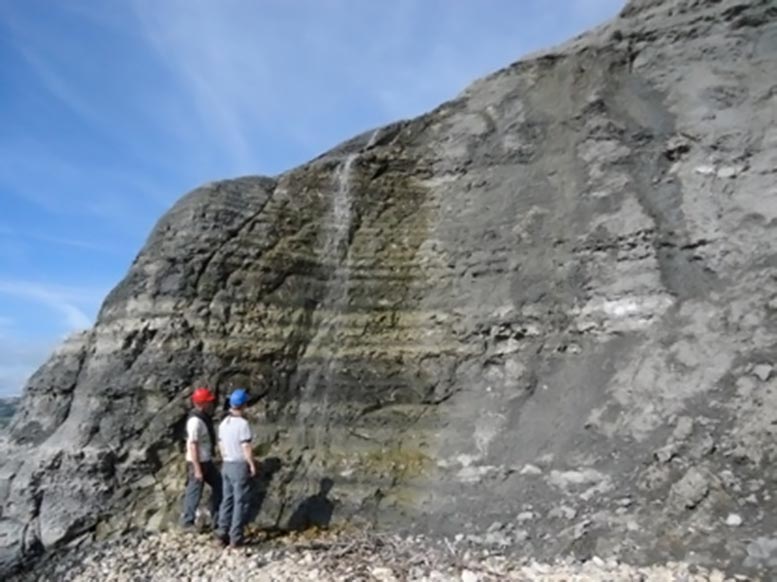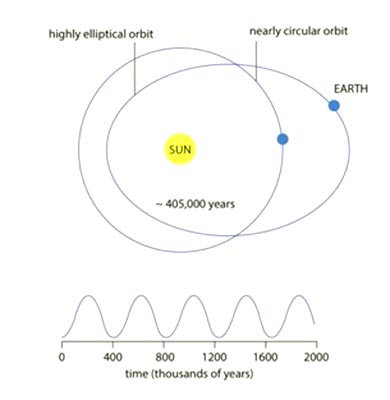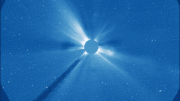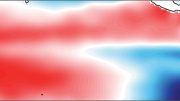
Geologists studying the Lower Jurassic (Pliensbachian) Belemnite Marl Member mudstone succession in Dorset, UK, showing orbitally paced variations of the sediment composition similar to the studied core in Wales. Credit: Dr. Micha Ruhl
The world is waking up to the fact that human-driven carbon emissions are responsible for warming our climate, driving unprecedented changes to ecosystems, and placing us on course for the sixth mass extinction event in Earth’s history.
However, new research publishing this week in the leading international journal PNAS, sheds fresh light on the complicated interplay of factors affecting global climate and the carbon cycle — and on what transpired millions of years ago to spark two of the most devastating extinction events in Earth’s history.
Using chemical data from ancient mudstone deposits in Wales, an international team involving scientists from Trinity College Dublin discovered that periodic changes in the shape of Earth’s orbit around the Sun were partly responsible for changes in the carbon-cycle and global climate during and in between the Triassic-Jurassic Mass Extinction (around 201 million years ago, when around 80% of the species on Earth disappeared forever) and the Toarcian Oceanic Anoxic Event (around 183 million years ago).

The eccentricity of the Earth’s orbit around the Sun. The fluctuation between a nearly circular and elliptical orbit drives cyclic changes in the Earth’s environment, including the global carbon cycle. Credit: Marisa Storm
In addition, volcanic activity released large amounts of greenhouse gases into the oceans and atmosphere at that point in time, which resulted in major global carbon cycle perturbations as well as global climate and environmental change.
Dr. Micha Ruhl, Assistant Professor in Sedimentology at Trinity, said:
“Our work shows that for the 18 million years or so in between the Triassic-Jurassic mass extinction and the Toarcian Oceanic Anoxic Event, Earth’s global carbon-cycle was in a constant state of change.”
“Periodic changes in the shape of Earth’s orbit around the sun impacted on the amount of energy received by Earth from the sun, which in turn impacted climatic and environmental processes, as well as the carbon-cycle, on local, regional, and global scales.”
“Although this phenomenon is well known for having caused the glacial cycles in more recent times, the present study shows that these external forcing mechanisms on Earth’s systems were also operating, and controlling Earth’s carbon cycle in the distant past, even during non-glacial times when Earth was marked by hot-house climate conditions.”
Present-day orbital configurations and solar system processes should have resulted in a future return to glacial conditions. However, anthropogenic carbon release will likely have disrupted this natural process, causing rapid global warming, rather than a steady return to cooler climates.
The study of past global change events, such as the end-Triassic mass extinction and the Toarcian Oceanic Anoxic Event, as well as the time in between, allows scientists to disentangle the different processes that control global carbon cycle change and constrain tipping points in Earth’s climate system.
A major international research team, made up of scientists from across Europe, North and South America and China, and including Dr. Micha Ruhl and other researchers from Trinity, will soon commence drilling a 1 km deep borehole to retrieve rock samples.
These samples will comprise detailed climatic and environmental information and allow for further improved understanding of the processes that led to past major global change events and mass extinctions. Drilling of this borehole will occur as part of the International Continental Drilling Program.
Reference: “Orbital pacing and secular evolution of the Early Jurassic carbon cycle” by Marisa S. Storm, Stephen P. Hesselbo, Hugh C. Jenkyns, Micha Ruhl, Clemens V. Ullmann, Weimu Xu, Melanie J. Leng, James B. Riding and Olga Gorbanenko, 10 February 2020, Proceedings of the National Academy of Sciences.
DOI: 10.1073/pnas.1912094117









So the industrial revolution may have come at the perfect time for humanity. Increased carbon emissions may be keeping us out of the ice-age that was predicted in the 80s. We need better understanding of these processes so that we can manage greenhouse emissions to counter cooling from solar minimum and orbital changes without overshooting into hothouse conditions. there is still hope.